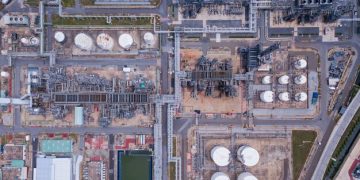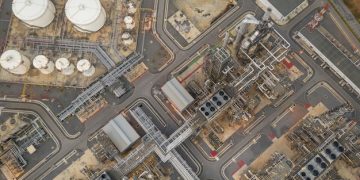New US Methane Regulations: Impact on Oil & Gas Industry
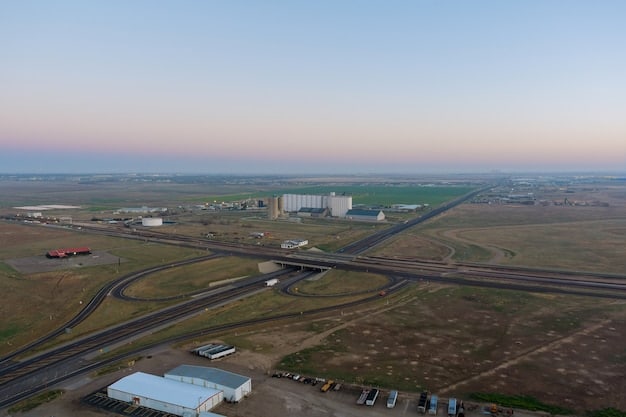
New US regulations for methane emissions aim to significantly reduce greenhouse gas emissions from the oil and gas industry by implementing stricter monitoring, reporting, and leak detection requirements, potentially reshaping operational practices and investment strategies.
The US government is implementing new regulations targeting methane emissions from the oil and gas industry. These rules aim to curb a potent greenhouse gas and mitigate climate change risks. Let’s delve into the scope, implications, and challenges surrounding these new measures.
Understanding Methane’s Impact and the Need for Regulation
Methane is a greenhouse gas far more potent than carbon dioxide over a shorter timeframe. Its impact on global warming prompted environmental agencies to prioritize its reduction. These rules are designed to minimize methane leakage from various sources within the oil and gas sector.
Methane traps significantly more heat in the atmosphere compared to carbon dioxide over a 20-year period, making it a critical target for immediate climate action. The oil and gas industry is a major source of methane emissions, with leaks occurring during production, processing, transmission, and distribution.
Why Methane Matters
Addressing methane emissions is crucial for meeting global climate goals and preventing near-term temperature increases. The new regulations reflect a growing recognition of the urgency to curb methane releases from the oil and gas sector.
Sources of Methane Emissions in the Oil and Gas Industry
Methane leaks can occur from various sources, including:
- Equipment leaks: Valves, connectors, and other components can develop leaks over time.
- Venting and flaring: Intentional releases of methane during maintenance or equipment malfunctions.
- Storage tanks: Emissions from storage tanks can contribute significantly to overall methane levels.
- Pipelines: Leaks from aging or damaged pipelines.
Understanding these sources is essential in targeting effective mitigation strategies.
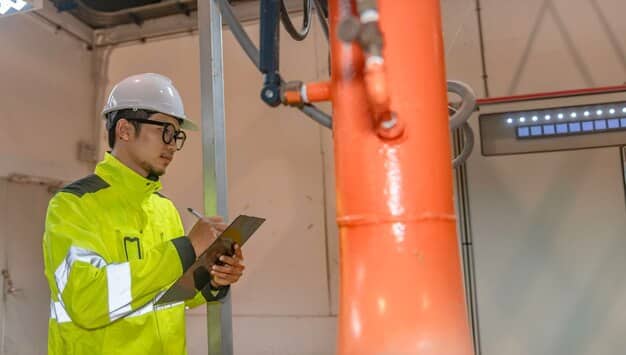
These regulations are not merely suggestions; they carry legal weight, compelling companies to actively monitor and reduce their **methane emissions**. Failing to comply can result in substantial penalties and legal repercussions, encouraging a shift towards more responsible operational practices.
Key Provisions of the New US Regulations
The new regulations introduce several key provisions aimed at reducing methane emissions from the oil and gas industry. These include stricter monitoring, reporting, and leak detection requirements, as well as mandates for replacing or upgrading outdated equipment.
These regulations aim to establish a comprehensive framework for addressing methane emissions across the entire oil and gas supply chain, from wellheads to processing plants and transmission pipelines.
Enhanced Monitoring and Reporting
Companies will be required to implement advanced monitoring technologies to detect and quantify methane emissions. Regular reporting to environmental agencies will ensure transparency and accountability.
Leak Detection and Repair Programs (LDAR)
Mandatory LDAR programs will require companies to regularly inspect their facilities for methane leaks and promptly repair any identified issues. This proactive approach aims to minimize fugitive emissions.
- Regular inspections using advanced technologies
- Prompt repair of identified leaks
- Implementation of best management practices to prevent future leaks
- Comprehensive record-keeping and reporting
These measures are designed to ensure that methane leaks are identified and addressed quickly and effectively.
Compliance with these regulations will likely require significant investment in new technologies and infrastructure upgrades, which may pose challenges for some companies. However, the long-term benefits of reducing methane emissions outweigh the initial costs.
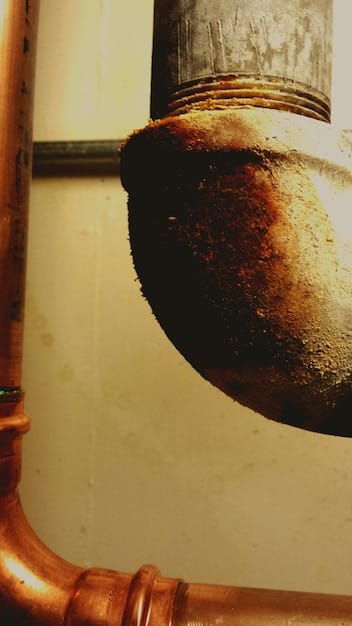
Impact on Oil and Gas Industry Operations
The new regulations will significantly impact the operational practices of the oil and gas industry. Companies will need to invest in new technologies, implement enhanced monitoring programs, and adopt best management practices to comply with the new rules.
The impact will be felt across various aspects of industry operations, from well completion and production to processing, transportation, and storage.
Increased Compliance Costs
Companies can expect increased costs associated with monitoring, reporting, and repairing methane leaks. Upgrading aging infrastructure and implementing new technologies will also require substantial investments.
Operational Changes and Best Practices
The industry may need to adopt new operational practices to minimize methane emissions, such as:
- Reducing venting and flaring during well completion
- Implementing vapor recovery systems on storage tanks
- Replacing high-bleed pneumatic devices with low- or zero-emission alternatives
- Improving pipeline integrity management
Adopting these best practices can significantly reduce methane emissions and improve overall operational efficiency.
Despite the perceived challenges, these regulations present opportunities for innovation and technological advancements in the oil and gas sector. Companies that embrace these changes and invest in cleaner technologies can gain a competitive edge in the evolving energy landscape.
Technological Innovations for Methane Reduction
The regulations drive the deployment and development of technology to mitigate methane emissions. From advanced leak detection systems to novel equipment designs, companies explore new solutions to lessen their environmental footprint.
Technological advancements are essential for achieving significant reductions in methane emissions from the oil and gas industry. Innovative solutions can help companies comply with the new regulations while improving operational efficiency.
Advanced Leak Detection Technologies
New technologies such as aerial surveys, satellite monitoring, and drones equipped with infrared cameras can detect methane leaks more efficiently and accurately than traditional methods.
Equipment Upgrades and Replacements
Replacing outdated equipment with modern, low-emission alternatives can significantly reduce methane leakage. This includes:
- Replacing high-bleed pneumatic devices with low- or zero-emission alternatives
- Installing vapor recovery systems on storage tanks
- Upgrading pipeline infrastructure to prevent leaks
- Implementing advanced control systems to optimize combustion efficiency
These upgrades can lead to substantial reductions in methane emissions and improve overall operational performance.
Collaboration between industry, government, and research institutions is crucial for fostering technological innovation and accelerating the deployment of methane reduction solutions. Incentives and funding programs can further encourage the development and adoption of new technologies.
Economic Implications and Market Impacts
The new regulations have economic implications for the oil and gas industry and the broader energy market. Increased compliance costs may impact profitability, while the demand for methane reduction technologies could create new market opportunities.
The economic landscape of the oil and gas industry is expected to shift as companies adapt to the new regulatory environment. Understanding these implications is crucial for both industry stakeholders and policymakers.
Impact on Oil and Gas Prices
Increased compliance costs may lead to higher production costs, potentially impacting oil and gas prices. However, the extent of these impacts will depend on various factors, including the availability of cost-effective methane reduction technologies and the overall supply and demand dynamics in the energy market.
Creation of New Market Opportunities
The new regulations could stimulate demand for methane reduction technologies and services, creating new market opportunities for companies specializing in leak detection, equipment upgrades, and emissions monitoring. This could lead to job creation and economic growth in the green technology sector.
The long-term economic benefits of reducing methane emissions, such as mitigating climate change impacts and improving public health, outweigh the short-term costs of compliance. Investing in methane reduction now can lead to a more sustainable and resilient energy future.
Challenges and Opportunities for the Industry
The oil and gas industry faces both challenges and opportunities as it adapts to the new methane regulations. Overcoming challenges and capitalizing on opportunities will be essential for ensuring a sustainable and competitive future.
Navigating this new regulatory landscape requires a strategic approach that balances compliance with innovation and economic viability.
Ensuring Compliance and Enforcement
Effective enforcement of the new regulations will be critical for achieving meaningful reductions in methane emissions. This requires adequate funding for environmental agencies, robust monitoring programs, and clear penalties for non-compliance.
Addressing legacy methane emissions from abandoned wells and other sources also poses a significant challenge. These emissions can contribute significantly to overall methane levels and require specialized mitigation strategies.
Promoting Collaboration and Knowledge Sharing
Promoting collaboration and knowledge sharing among industry stakeholders, government agencies, research institutions, and environmental groups can accelerate the development and deployment of methane reduction solutions. Sharing best practices and lessons learned can help the industry overcome challenges and maximize the benefits of the new regulations.
The new methane regulations present a significant opportunity for the oil and gas industry to demonstrate its commitment to environmental stewardship and contribute to a cleaner energy future. By embracing innovation, investing in methane reduction technologies, and collaborating with stakeholders, the industry can thrive in the evolving energy landscape.
| Key Point | Brief Description |
|---|---|
| 🚀 Regulation Goals | Reduce methane emissions to combat climate change. |
| 💰 Cost Impact | Increased compliance costs for the oil and gas sector. |
| ⚙️ Tech Adoption | Drive the deployment of advanced leak detection technologies. |
| 🌱 Market Shift | New market opportunities for green tech innovators. |
Frequently Asked Questions
▼
The regulations aim to dramatically decrease methane emissions from the oil and gas sector, a key step in combating climate change and protecting public health by controlling a potent greenhouse gas.
▼
Companies will face increased costs, need to implement better monitoring for methane leaks, and must adopt updated technologies to comply. This includes infrastructure overhauls and best practice implementations.
▼
Advanced leak detection systems like aerial surveys and drones with infrared cameras, as well as equipment upgrades like replacing high-bleed pneumatic devices, are vital for effective mitigation.
▼
The increase in compliance costs for energy companies may increase consumer prices, which depends on market forces and the effectiveness of cost-efficient mitigation technologies being implemented.
▼
Beyond reducing greenhouse gases, they foster technological innovation, create jobs in green technologies, and enhance public health by reducing air pollution, which makes for a safer and healthier community.
Conclusion
The new US regulations for methane emissions represent a critical step towards mitigating climate change and promoting a more sustainable energy future. While the oil and gas industry faces challenges in adapting to these rules, they also present significant opportunities for innovation and long-term competitiveness. By embracing technological advancements, investing in cleaner operations, and collaborating with stakeholders, the industry can navigate these changes and contribute to a cleaner, healthier environment for all.
